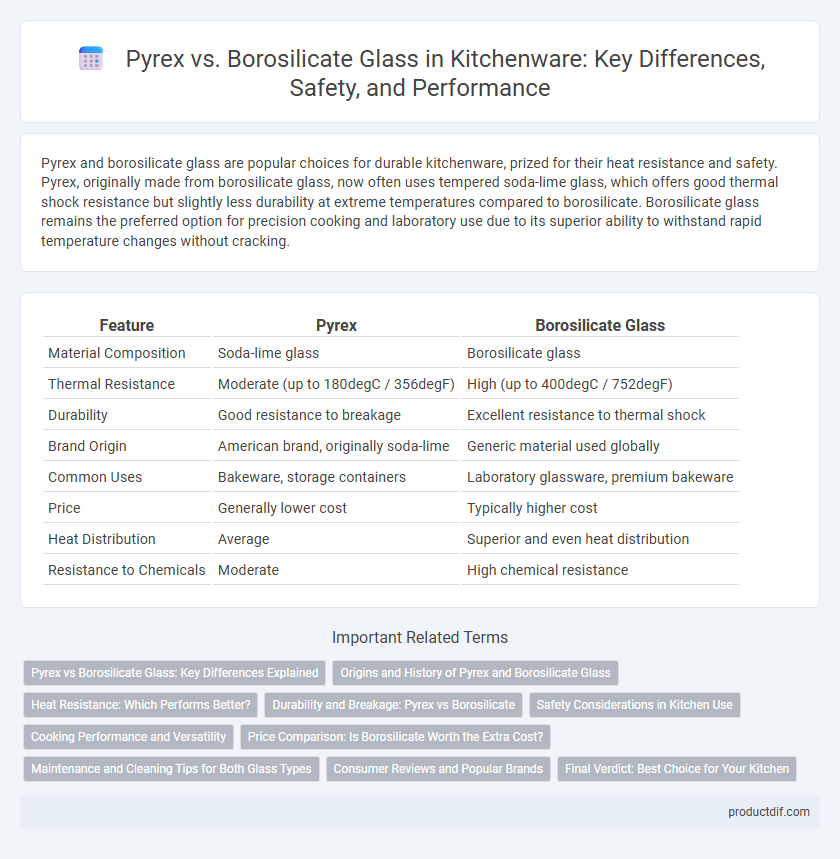Pyrex and borosilicate glass are popular choices for durable kitchenware, prized for their heat resistance and safety. Pyrex, originally made from borosilicate glass, now often uses tempered soda-lime glass, which offers good thermal shock resistance but slightly less durability at extreme temperatures compared to borosilicate. Borosilicate glass remains the preferred option for precision cooking and laboratory use due to its superior ability to withstand rapid temperature changes without cracking.
Table of Comparison
| Feature | Pyrex | Borosilicate Glass |
|---|---|---|
| Material Composition | Soda-lime glass | Borosilicate glass |
| Thermal Resistance | Moderate (up to 180degC / 356degF) | High (up to 400degC / 752degF) |
| Durability | Good resistance to breakage | Excellent resistance to thermal shock |
| Brand Origin | American brand, originally soda-lime | Generic material used globally |
| Common Uses | Bakeware, storage containers | Laboratory glassware, premium bakeware |
| Price | Generally lower cost | Typically higher cost |
| Heat Distribution | Average | Superior and even heat distribution |
| Resistance to Chemicals | Moderate | High chemical resistance |
Pyrex vs Borosilicate Glass: Key Differences Explained
Pyrex originally referred to borosilicate glass, prized for its thermal resistance and durability, but modern Pyrex in the U.S. is often made from soda-lime glass, which is less heat-resistant but more affordable. Borosilicate glass contains about 13% boron oxide, providing superior resistance to thermal shock, making it ideal for laboratory use and high-temperature cooking. Consumers seeking high-performance kitchenware should note that genuine borosilicate glass offers greater durability under rapid temperature changes compared to contemporary Pyrex products made from soda-lime glass.
Origins and History of Pyrex and Borosilicate Glass
Pyrex originated in 1915 as a brand of borosilicate glass developed by Corning Glass Works, designed for its thermal resistance and durability in kitchenware. Borosilicate glass itself was invented in the late 19th century by German glassmaker Otto Schott, prized for its low thermal expansion and chemical stability. Over time, Pyrex evolved to include soda-lime glass in some regions, but its roots remain deeply linked to borosilicate's pioneering heat-resistant properties.
Heat Resistance: Which Performs Better?
Pyrex originally used borosilicate glass known for its exceptional heat resistance and thermal shock durability, allowing it to withstand rapid temperature changes without cracking. Modern Pyrex sold in the United States often uses soda-lime glass, which has lower heat resistance compared to borosilicate, making it more prone to thermal shock but more affordable. For high heat resistance and durability in kitchenware, borosilicate glass outperforms soda-lime glass versions of Pyrex in resisting sudden temperature changes.
Durability and Breakage: Pyrex vs Borosilicate
Pyrex glass, originally made from borosilicate, now consists of soda-lime glass which offers good durability but is more prone to thermal shock and breakage compared to borosilicate glass. Borosilicate glass features higher resistance to temperature fluctuations and mechanical stress, making it significantly more durable in kitchenware applications where rapid temperature changes occur. The enhanced thermal durability of borosilicate reduces the risk of cracks and breakage, ensuring longer-lasting performance in cookware and bakeware.
Safety Considerations in Kitchen Use
Borosilicate glass offers superior thermal shock resistance, making it safer for abrupt temperature changes during cooking and baking compared to standard Pyrex made from soda-lime glass. While modern Pyrex in the U.S. is now primarily soda-lime glass, it still withstands normal kitchen temperatures but may be more prone to cracking under sudden temperature shifts. For enhanced safety in kitchen use, especially when transferring dishes from freezer to oven, borosilicate glass provides greater durability and reduces breakage risk.
Cooking Performance and Versatility
Pyrex glassware, primarily made from tempered soda-lime glass, offers excellent thermal shock resistance suitable for everyday baking and microwave use, but it may be less durable under sudden extreme temperature changes than borosilicate glass. Borosilicate glass, known for its superior heat tolerance and chemical resistance, excels in both stovetop cooking and oven use, providing greater versatility for high-temperature recipes and precise temperature control. Both types perform well in cooking, but borosilicate glass's enhanced durability and heat resistance make it more versatile for professional and specialized culinary applications.
Price Comparison: Is Borosilicate Worth the Extra Cost?
Borosilicate glass kitchenware typically costs 20-50% more than Pyrex due to its superior thermal shock resistance and durability. While Pyrex made from soda-lime glass offers affordability and decent performance, borosilicate is preferred for professional or frequent high-heat usage because it reduces breakage risk. The higher initial price of borosilicate often pays off in longevity and safety for users requiring reliable heat tolerance.
Maintenance and Cleaning Tips for Both Glass Types
Pyrex and borosilicate glass both require careful handling to maintain clarity and durability; avoid abrasive cleaners and metal scrubbers that can cause scratches. Use warm, soapy water or dishwasher-safe detergents for effective cleaning, and immediately dry after washing to prevent water spots. Regularly inspect for chips or cracks to ensure safe use and prolong the lifespan of your glass kitchenware.
Consumer Reviews and Popular Brands
Consumer reviews highlight Pyrex's strong reputation for durability and thermal shock resistance, making it a preferred choice for everyday kitchenware. Borosilicate glass, favored by brands like Corelle and Simax, receives praise for its lightweight design and superior heat tolerance, ideal for precision cooking. Popular brands offering borosilicate options emphasize non-toxic materials and long-lasting clarity, appealing to health-conscious consumers seeking reliable bakeware.
Final Verdict: Best Choice for Your Kitchen
Borosilicate glass offers superior thermal resistance and durability, making it ideal for frequent use in high-temperature cooking and baking. Pyrex, often made from tempered soda-lime glass, provides affordable and reliable options for everyday kitchen tasks but may be less resistant to thermal shock. For long-term investment and resilience in professional or intensive home kitchens, borosilicate glass is the best choice.
Pyrex vs Borosilicate glass Infographic

 productdif.com
productdif.com